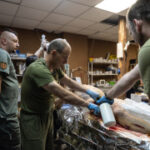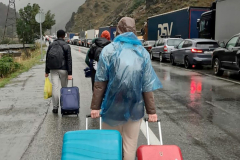The Russian occupation governor of Ukraine’s eastern Luhansk region claimed it had been entirely conquered on Tuesday, making it the first of the four eastern Ukrainian regions Russia has annexed that it fully controls.
“Just a couple of days ago, I received a report that the territory of the Luhansk People’s Republic has been 100 percent liberated,” Leonid Pasechnik told Russia’s TV Channel One.
Not everyone agreed.
Russian military reporters said two villages remained free, and pointed out that Luhansk had been declared conquered once before, in 2022, before being partially reclaimed in a Ukrainian counteroffensive in September of that year.
Undoubtedly, though, Russian forces have inched towards reconquering the entire territory in the intervening 33 months, and that constitutes a second milestone within the past month on Ukraine’s eastern front.
Russia’s advance dealt another blow to Ukraine, more than three years after the full-scale invasion began. On the same day as Pasechnik’s announcement, the United States said it would not be sending Kyiv some weapons that had been promised by the administration of Joe Biden, the former US president.
“This decision was made to put America’s interests first following a review of our nation’s military support and assistance to other countries across the globe,” said the White House.

Russian troops reached the border of the Dnipropetrovsk region over the weekend of June 7-8, marking the first time in the war they had conquered the entire breadth of the Donetsk region at any point, even though about a third of it remains in Kyiv’s hands.
These milestones may be strategically meaningless, as they do not mark a breakthrough or a pace change in the Russian forces’ crawling advance, but they demonstrate that Ukrainian forces are also unable to turn the tide.
The Russian Ministry of Defence claimed its forces had taken the villages of Zaporizhzhia, Perebudova, Shevchenko and Yalta in Donetsk on June 27, proceeding to Chervona Zirka the following day and Novoukrainka on Sunday.
Through such small but constant conquests, Russia has given its offensive in Ukraine an inexorable feeling.
The buffer bluff
“Naturally, the Russian armed forces are now tasked to continue operations to establish a buffer zone. According to experts, it should stretch at least 70 to 120 kilometres (40 to 75 miles) deep inside Ukraine,” Igor Korotchenko, the editor of National Defense magazine, told TASS.
Such statements have come before from Russian officials and pro-Moscow pundits.
Last March, when Russian forces recaptured Kursk, a Russian region Ukraine had counter-invaded, battalion deputy commander Oleg Ivanov told TASS it was now necessary to create a buffer zone “no less than 20km [12 miles] wide, and preferably 30km [19 miles], extending deep into Ukrainian territory,” so that residents of Kursk would be safe from Ukrainian counterattack.

In May, deputy chairman of Russia’s National Security Council Dmitry Medvedev said that “if military aid to the regime of bandits continues”, referring to Kyiv, “the buffer zone could look like this” – and he posted a map on his Telegram channel, showing almost all of Ukraine shaded.
When Russian troops reached the Dnipropetrovsk border last month, Kremlin spokesperson Dmitry Peskov said they had begun new offensive operations in that region “within the framework of the creation of a buffer zone”.
Officially, the Kremlin has annexed only Luhansk, Donetsk, Zaporizhia and Kherson, but given that Russian President Vladimir Putin on June 20 revealed he still regarded all of Ukraine as Russian territory, many experts believe these buffer zones are little more than an excuse to continue capturing as much Ukrainian territory as possible.
On June 27, Putin referred to his goals more cryptically, telling journalists at the Eurasian Economic Union summit in Minsk that “we want to conclude the special military operation with the result that we need”.

In May, he called for a buff





